Excavating the Tomb of Tutankhamun
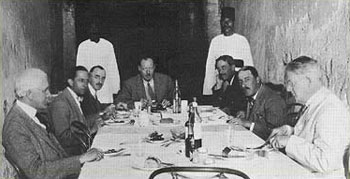 The
tomb of Tutankhamun, which is today designated as KV 62, was
number 4.33 in Howard Carter's sequence of discoveries since
1915. It did not take Lord Carnarvon and Carter long to appreciate
the enormity of the discovery and its implications. While
Arthur Callender, a close friend of Carter, had been helping
him, more assistance in clearing the tomb would certainly
be needed. When, soon after the discovery, Albert Lythgoe,
then Curator of the Metropolitan Museum's Egyptian Department,
cabled his congratulations and offered help, Carter took him
at his word, responding:
The
tomb of Tutankhamun, which is today designated as KV 62, was
number 4.33 in Howard Carter's sequence of discoveries since
1915. It did not take Lord Carnarvon and Carter long to appreciate
the enormity of the discovery and its implications. While
Arthur Callender, a close friend of Carter, had been helping
him, more assistance in clearing the tomb would certainly
be needed. When, soon after the discovery, Albert Lythgoe,
then Curator of the Metropolitan Museum's Egyptian Department,
cabled his congratulations and offered help, Carter took him
at his word, responding:
"Thanks message [of congratulations]. Discovery
colossal and need every assistance. Could you consider load
of Burton in recording in time being? Costs to us. Immediately
reply would oblige. Every regard, Carter, Continental, Cairo."
Close ties had already existed between Carter, Carnarvon
and the Metropolitan Museum, and so Carter was granted his
request. In due course, the Metropolitan Museum's generosity
would be rewarded when Carter helped them acquire the Carnarvon
collection.
However, within a matter of days, Carter received
other offers of help. On December 9th Alfred Lucas, a chemist
with the Egyptian Government, came forward. With him aboard,
the clearance of Tutankhamun's tomb seems to have been the
first ever archaeological expedition to have its own resident
chemist.
Then on December 12th Arthur Mace, an Egyptologist
with the Metropolitan Expedition, was also put at Carter's
disposal. Six days later, James Breasted, Director of the
Oriental Institute in Chicago arrived to begin work on the
seal impressions which covered the plastered blockings. The
Metropolitan team also provided him with Hauser and Hall,
two architects who began work on drawing a plan of the objects
in situ. Then, on January 3rd, Alan Gardiner, a British philologist,
arrived to start work on the inscriptions.
Others would eventually join the team, including
Percy Newberry, another of Carter's old friends. It became
a showpiece of academic cooperation that would in time also
draw in Douglas Derry of the Cairo Anatomy School, and Seleh
Bey Hamdi of Alexandria to conduct the postmortem examination
of the mummy, Battiscombe Gunn to 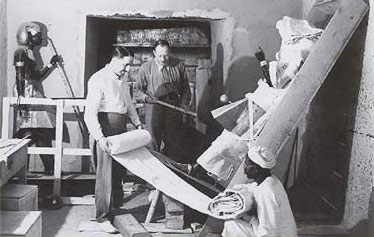 work
on the ostraca for the final publication, L. A. Boodle, a
botanist from Kew Gardens, James R. Ogden, a Harrogate jeweler
to report on aspects of the gold work, Alexander Scott and
H. J. Plenderleith of the British Museum for analytical assistance,
G. F. Hulme of the Geological Survey of Egypt, and others.
work
on the ostraca for the final publication, L. A. Boodle, a
botanist from Kew Gardens, James R. Ogden, a Harrogate jeweler
to report on aspects of the gold work, Alexander Scott and
H. J. Plenderleith of the British Museum for analytical assistance,
G. F. Hulme of the Geological Survey of Egypt, and others.
Part of the reason that there was so much politics
surrounding the discovery and excavation of the tomb of Tutankhamun
was that Howard Carter was a very advanced excavator for his
time. It is said that anyone else would have had the tomb
cleared and the objects it contained on display within a month
of the tomb's discovery, but it took Carter almost a decade
to carefully preserve and remove the treasures to Cairo. The
difference shows the caution with which Carter approached
this undertaking, which more resembles the efforts of modern
excavators.
Of course, most of the political challenges came
in the first two seasons of work, creating distractions and
difficulties, but afterwards, Carter and his team settled
into a thorough and methodical routine, maintaining 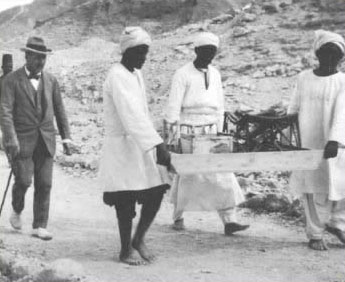 complete
records for each discovery and working to preserve each antiquity
as they were brought out of the tomb. The excavation used
the tomb of Ramesses XI (KV4) as a storeroom for supplies
and for minor finds from the stairwell and corridor, and later
the tomb of Seti II (KV15) was turned into a secure field
conservation laboratory and photographic studio. Also, KV55,
just across the path from the Tut's tomb, was made into a
darkroom for Harry Burton.
complete
records for each discovery and working to preserve each antiquity
as they were brought out of the tomb. The excavation used
the tomb of Ramesses XI (KV4) as a storeroom for supplies
and for minor finds from the stairwell and corridor, and later
the tomb of Seti II (KV15) was turned into a secure field
conservation laboratory and photographic studio. Also, KV55,
just across the path from the Tut's tomb, was made into a
darkroom for Harry Burton.
Howard Carter established a routine for processing
what must have seemed like an endless flow of treasures from
the tomb. Each object or group of objects was given a reference
number. The main reference numbers ranged from 1 to 620, though
there were subdivisions for objects within a numbered group
denoted by the use of single or multiple letters (a, b, c,
etc). Additional subdivisions were noted by bracketed Arabic
numerals. Group no. 620 is anomalous in that it was given
subdivisions numbered from 1 to 123. (i.e. 620:1 to 620:123).
The distribution of object numbers throughout the
tomb was as follows:
1a-3
4
5a-12t
13
14-170
28
172-260
261-336
171
337-620:123
|
Entrance staircase
first sealed doorway
Corridor
second sealed doorway
Antechamber
sealed doorway into the Burial Chamber
Burial Chamber
Treasury
partially dismantled Annex blocking
Annex
|
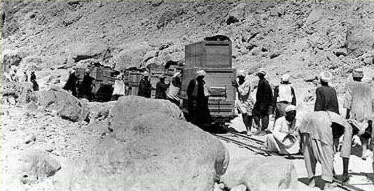 After
objects in the tomb were provided with reference numbers,
photographs were taken of the items in situ with and without
the reference number cards. The camera was repositioned several
times in order to show every object at least once in one of
the shots. A brief description was also provided, as well
as a sketch if appropriate, on a numbered record card (by
Carter or Mace), and the place of the objects discovery was
located on a ground plan of the tomb (prepared by Hall and
Hauser). Afterwards, the piece was removed to the laboratory
for treatment by Lucas and Mace, where more photographs were
made. After the conservation of the object was completed,
a further photograph was made. This routine was carried out
for many thousands of objects, over several seasons, sometimes
in sweltering heat, and under pressure from the press, who
were soon complaining about the excessive time the clearance
was taking. There was also a constant flow of visitors to
the tomb, including some 12,000 at the height of the King
Tut hysteria between January 1 and March 15th, 1926.
After
objects in the tomb were provided with reference numbers,
photographs were taken of the items in situ with and without
the reference number cards. The camera was repositioned several
times in order to show every object at least once in one of
the shots. A brief description was also provided, as well
as a sketch if appropriate, on a numbered record card (by
Carter or Mace), and the place of the objects discovery was
located on a ground plan of the tomb (prepared by Hall and
Hauser). Afterwards, the piece was removed to the laboratory
for treatment by Lucas and Mace, where more photographs were
made. After the conservation of the object was completed,
a further photograph was made. This routine was carried out
for many thousands of objects, over several seasons, sometimes
in sweltering heat, and under pressure from the press, who
were soon complaining about the excessive time the clearance
was taking. There was also a constant flow of visitors to
the tomb, including some 12,000 at the height of the King
Tut hysteria between January 1 and March 15th, 1926.
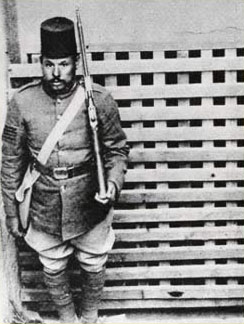 Clearance
of the Antechamber was begun on December 27th 1922. It took
seven weeks to finish, and used up more than a mile of cotton
wadding and 32 bales of calico to secure the objects. Afterwards,
and at the end of each successive season, the objects were
crated up with extreme care using hundreds of feet of timber,
and transported to the Nile river using the human powered
Decauville (narrow gauge) railway. Though only a relatively
short distance, the train track was not permanent and Carter
was given only a meager number of rail-lengths that had to
be constantly "leapfrogged", so it took some 15 hours to move
the train to the river during the heat of the summer months.
Clearance
of the Antechamber was begun on December 27th 1922. It took
seven weeks to finish, and used up more than a mile of cotton
wadding and 32 bales of calico to secure the objects. Afterwards,
and at the end of each successive season, the objects were
crated up with extreme care using hundreds of feet of timber,
and transported to the Nile river using the human powered
Decauville (narrow gauge) railway. Though only a relatively
short distance, the train track was not permanent and Carter
was given only a meager number of rail-lengths that had to
be constantly "leapfrogged", so it took some 15 hours to move
the train to the river during the heat of the summer months.
Only the gold coffin and mask were not transported
by river. They were conveyed by a train in a special "Service
Car" with an armed guard from the Egyptian army.
At the end of each season, for security against not
only theft but also floods, the tomb entrance was covered
over with a watertight wooden blocking erected over a wooden
portcullis, and guarded by a local policeman.
Carter would later tell us that:
"It had been our privilege to find the most important
collection of Egyptian antiquities that had ever seen the
light, and it was for us to show that we were worthy of the
trust."
See also: